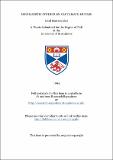Mechanistic studies on glutamate mutase
Abstract
The coenzyme B12-dependent enzyme glutamate mutase (E.C. 5.4.99.1) catalyses the rearrangement of (2S)-glutamic acid to (2S,3S)-3-methylaspartic acid. Each of the two components of the enzyme was purified to homogeneity using a combination of low and high performance chromatographic techniques. Component E and S displayed molecular weights of 53 KDa and 13 KDa respectively as determined by gel electrophoresis, contrary to literature reports. A large number of glutamate and 3-methylaspartate analogues were synthesised and tested as substrates for the enzyme from Clostridium tetanomorphum. No rearrangement products could be detected for (2S,3R)-3-methylaspartic acid, (2S,3S)-3-ethylaspartic acid, 3-methylglutamic acid, (2S,3R)-3-methylsuccinic acid or A/-methyl-3-methylaspartic acid. Five inhibitors were discovered for the enzyme. Four of them were typical competitive inhibitors: (2S,3S)- and (2S,3R)-3-methylglutamates (Ki = 1.0 mM and Ki = 1.5 mM respectively); (2S)-homocysteic acid, Ki = 5 mM; and 1-bromo-cis-1,2-cyclopropanedicarboxylic acid (Ki= 2.2+/-0.2 mM). Finally 1-bromo-trans-1,2- cyclopropanedicarboxylic acid prevented the enzyme from processing (2S)- glutamic acid for periods of times proportional to its concentration. Our results support a radical mechanism with a protein bound glycyl radical as an intermediate, and provide evidence for the existence of two distinct conformations of the holoenzyme, prior to and after the activation of the cofactor. (2S,3R)-3- and (2S,3S)-3-Methylglutamic acids were synthesised stereospecifically by extending Schollkopf's bis-lactim ether methodology. The attack of various carbon anions at C-5 of isopropyl N-benzyl-(4S,5R)-1,2,3- oxathiazolidone-5-methyi-4-carboxyiate S,S-dioxide was not a versatile pathway. Nevertheless, the reaction of the oxathiazolidone with an allylmagnesium lithium cuprate complex gave some promising results, but more research is necessary to optimise certain problematic steps. Several different routes were evaluated for the preparation of 1-amino-1,2-cyciopropanedicarboxylic acid, but either low yields or instability of intermediates thwarted any attempts to achieve this goal. Finally 1- bromo-cis-and trans-1,2-cyclopropanedicarboxylic acids were synthesised by reacting methyl acrylate with methyl dibromoacetate in the presence of sodium hydride. The two pairs of enantiomers, cis- ((2S,3S) and (2R,3R)) and trans- ((2R,3S) and (2S,3R)) were separated by selective ester formation.
Type
Thesis, PhD Doctor of Philosophy
Collections
Items in the St Andrews Research Repository are protected by copyright, with all rights reserved, unless otherwise indicated.

